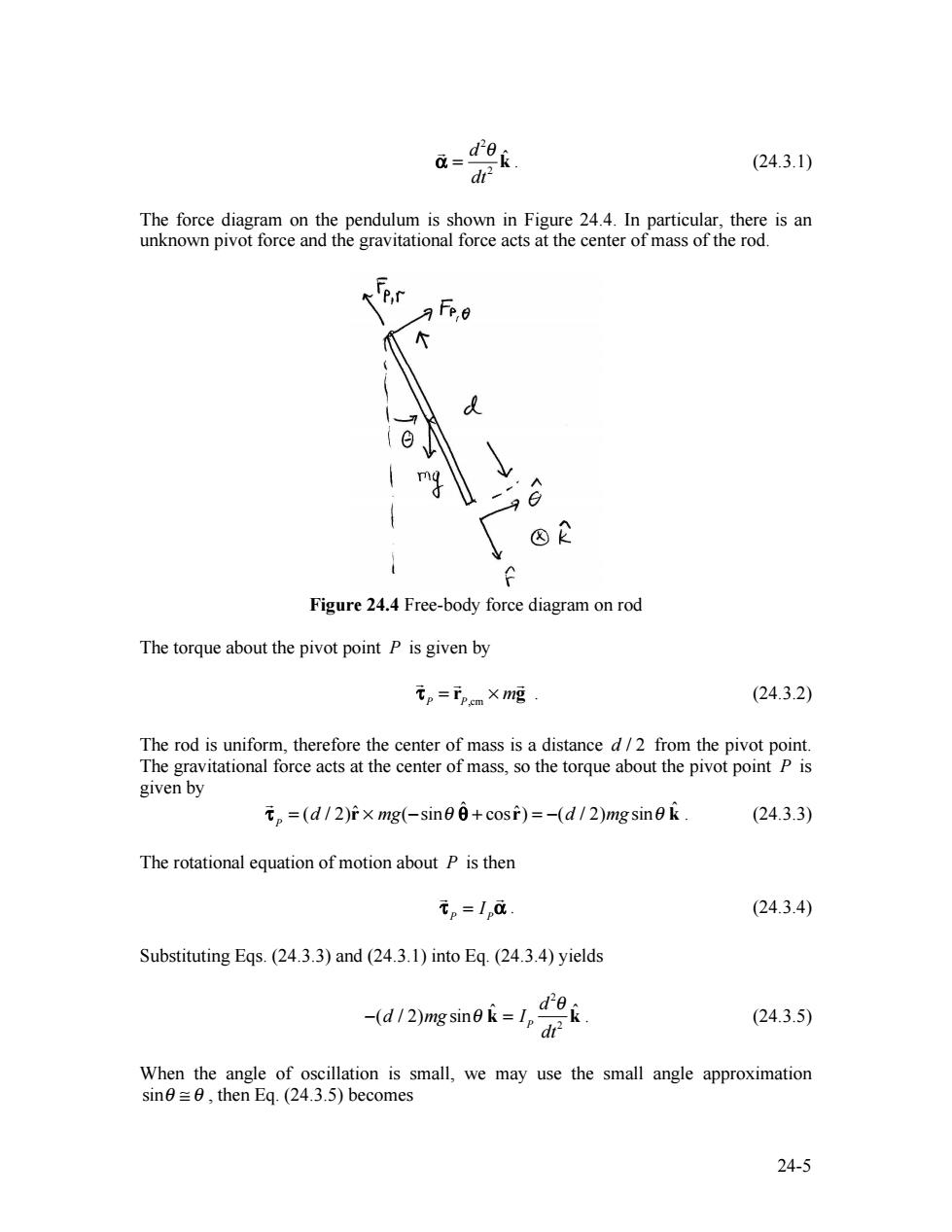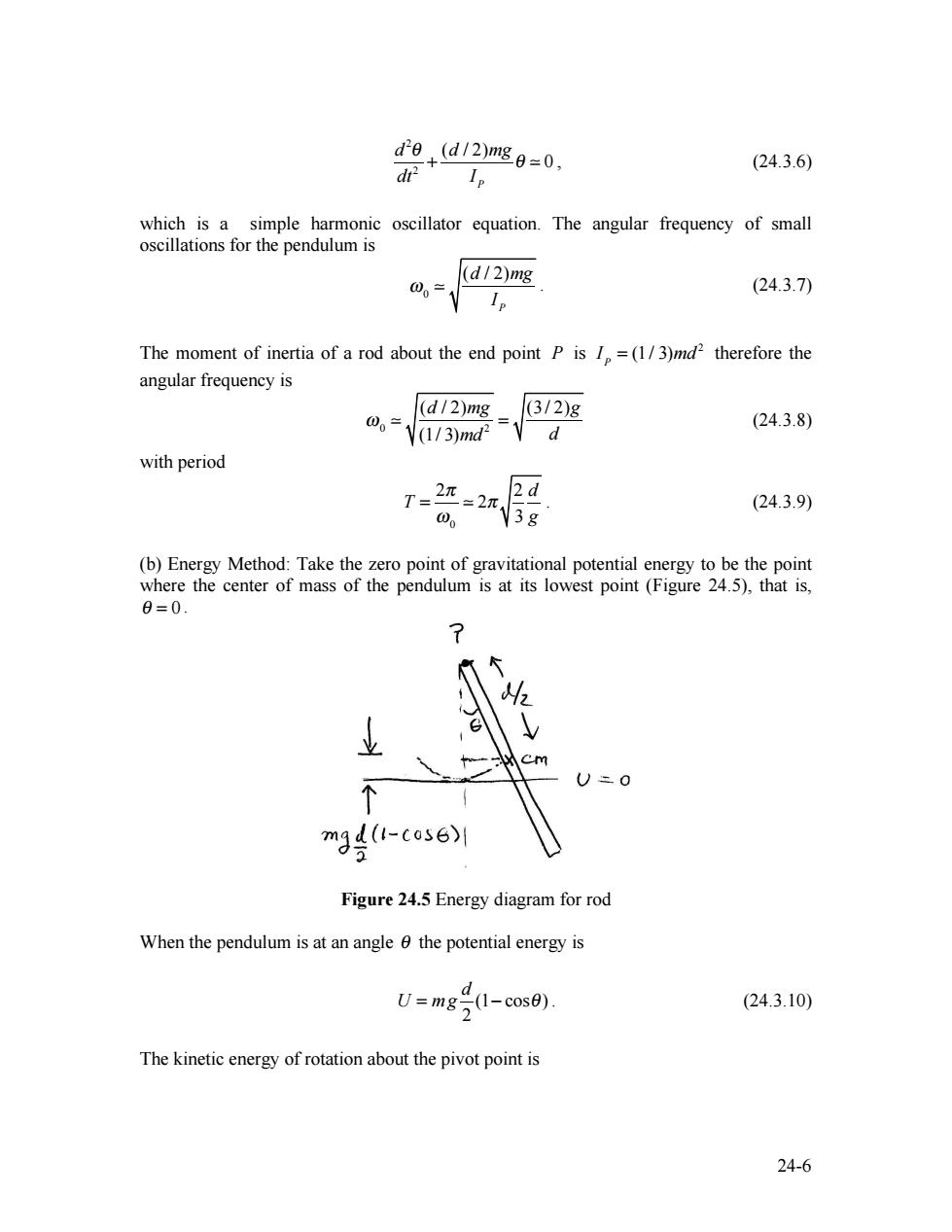
a= doi. (24.3.1) dr The force diagram on the pendulum is shown in Figure 24.4.In particular,there is an unknown pivot force and the gravitational force acts at the center of mass of the rod. 'Pr 个 m 因E Figure 24.4 Free-body force diagram on rod The torque about the pivot point P is given by 元p=Tpem x mg. (24.3.2) The rod is uniform,therefore the center of mass is a distance d/2 from the pivot point. The gravitational force acts at the center of mass,so the torque about the pivot point P is given by 元p=(d/2)f×mg(-sin66+cosf)=-(d/2)mg sin0k (24.3.3) The rotational equation of motion about P is then =Ia. (24.3.4) Substituting Egs.(24.3.3)and(24.3.1)into Eq.(24.3.4)yields -(d12)mg sin (24.3.5) When the angle of oscillation is small,we may use the small angle approximation sin0≡8,then Eq.(24.3.S)becomes 24-5
24-5 α = d2 θ dt 2 kˆ . (24.3.1) The force diagram on the pendulum is shown in Figure 24.4. In particular, there is an unknown pivot force and the gravitational force acts at the center of mass of the rod. Figure 24.4 Free-body force diagram on rod The torque about the pivot point P is given by τ P = rP,cm × m g . (24.3.2) The rod is uniform, therefore the center of mass is a distance d / 2 from the pivot point. The gravitational force acts at the center of mass, so the torque about the pivot point P is given by τ P = (d / 2)rˆ × mg(−sinθ ˆ θ + cosrˆ) = −(d / 2)mg sinθ kˆ . (24.3.3) The rotational equation of motion about P is then τ P = IP α . (24.3.4) Substituting Eqs. (24.3.3) and (24.3.1) into Eq. (24.3.4) yields −(d / 2)mg sinθ kˆ = IP d2 θ dt 2 kˆ . (24.3.5) When the angle of oscillation is small, we may use the small angle approximation sinθ ≅ θ , then Eq. (24.3.5) becomes

d9,(d/2)mg0=0, 3+ (24.3.6) Ip which is a simple harmonic oscillator equation.The angular frequency of small oscillations for the pendulum is (d/2)mg 00= (24.3.7) Ip The moment of inertia of a rod about the end point P is I=(1/3)md2 therefore the angular frequency is (d/2)mg (312)8 00 (24.3.8) V(1/3)md2 d with period 2d (24.3.9) 0。 (b)Energy Method:Take the zero point of gravitational potential energy to be the point where the center of mass of the pendulum is at its lowest point (Figure 24.5),that is, 0=0. 个 Cm 个 m9(4-co56)1 Figure 24.5 Energy diagram for rod When the pendulum is at an angle 0 the potential energy is U=mg(1-c0s0). (24.3.10) 2 The kinetic energy of rotation about the pivot point is 24-6
24-6 d2 θ dt 2 + (d / 2)mg IP θ 0 , (24.3.6) which is a simple harmonic oscillator equation. The angular frequency of small oscillations for the pendulum is ω0 (d / 2)mg IP . (24.3.7) The moment of inertia of a rod about the end point P is IP = (1/ 3)md2 therefore the angular frequency is ω0 (d / 2)mg (1/ 3)md2 = (3/ 2)g d (24.3.8) with period T = 2π ω0 2π 2 3 d g . (24.3.9) (b) Energy Method: Take the zero point of gravitational potential energy to be the point where the center of mass of the pendulum is at its lowest point (Figure 24.5), that is, θ = 0 . Figure 24.5 Energy diagram for rod When the pendulum is at an angle θ the potential energy is U = mg d 2 (1− cosθ). (24.3.10) The kinetic energy of rotation about the pivot point is